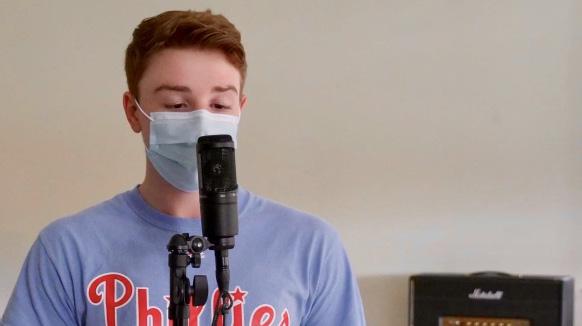
10 minute read
National conventions
off-campus opinions
National conventions define party startegies ahead of November election
Advertisement
WIKIMEDIA COMMONS Vice President Joe Biden moments before his speech on the final night of the Democratic National Convention on Thursday August 20, 2020.

Agustin Aliaga ‘21
As the election creeps closer, candidates Vice President Joe Biden and incumbent Donald Trump hasten their campaigns and ramp up internal support and fundraising. Both candidates’ parties mounted large efforts to make their national conventions a campaign-cycle turning point. While different, each convention had clearly set goals, and both sides mobilized near everything they had to accomplish them.
First was the Democratic National Convention (DNC). The convention’s speakers aimed to express that Joe Biden would restore a sense of normalcy that Donald Trump has taken from American politics. Several speeches from primary candidates, friends, and even former presidents Bill Clinton and Jimmy Carter extolled Biden’s character and record, but the most effective and captivating moment came with President Barack Obama’s address from Old City’s Museum of the American Revolution, where he analyzed the state of American democracy under the Trump administration and how Biden could restore it to its height. The party also showed that it was the party of cooperation and progress rather than the one of division and regress that it says Donald Trump has formed. Featured Republican speakers included former Secretary of State under George W. Bush Colin Powell and former Republican Ohio governor, congressman, and presidential candidate John Kasich. “I’m a lifelong Republican,” Kasich said, “but that attachment holds second place to my responsibility to my country.” The convention finished on its fourth day with one of Vice President Biden’s most convincing speeches to date. He detailed not only the policy plans for his administration but also how they would directly affect Americans for the better. The speech presented a perfect end to the convention, as it addressed the issues Democrats are looking to prioritize and also demonstrated a strong and electable Biden. The DNC was widely considered a success, with perhaps its only low point coming with Vice Presidential nominee, Kamala Harris’s speech on the penultimate night of the convention. The speech was not widely regarded as successful. Nonetheless, the party was effective in capitalizing both on its platform as the party of compassion and humanity as well as its support from what historically has been the opposition. The Republican National Convention (RNC) took a completely different path in attempting to raise votes for the November election. As it was in 2016, the party’s strategy was to excite the base rather than to encourage bipartisan support for its candidate. In this aspect, it was generally effective. The party emphasized key issues for its voters such as protection of Second Amendment rights, abortion laws, and, most importantly, the preservation of conservative values. Senate Majority Leader Mitch McConnell concentrated his speech on voting for Republicans up and down the ballot in order to preserve a majority in the Senate and regain control over the House of Representatives. It seemed that McConnell was chasing a “worst-case scenario,” where at least if there was a Biden presidency, a Republican Congress could halt its power to pass leftleaning legislation, much like the situation the Obama administration faced in its final years. Perhaps the only aspect of the convention that was not directly aimed to the right was the party’s attempt to empathize with minority constituencies. The party attempted to utilize stories of police officers who had been killed by protestors in order to differentiate between their stance on the Black Lives Matter (BLM) movement and an unwillingness to work for minorities. These stories appeared in conjunction with black speakers such as former presidential candidate Dr. Ben Carson and Senator Tim Scott, who defended the party’s commitment to equality. The attempt created an ideological clash within the convention, as the controversial couple who pointed guns at peaceful BLM protestors were given a chance to speak. These divisive speakers did not age well. Only days after the speech was delivered, seventeen-year old Kyle Rittenhouse did the same as the couple featured, but only this time shooting and killing two protestors in Kenosha, Wisconsin. Additionally, the party attempted to convince the American public that the Republican Party was one with the middle class. They defended the president’s tax cuts in this light and preached that a potential Biden administration would roll back the cuts only to fund unnecessary government programs that
The only ques- tion that remains is whether or not the Republican party made the right de- cision in doubling down on its strategy from 2016.
would not help middle-class Americans. The convention closed on its final night in an unprecedented way on the front lawn of the White House. The facade of the brightly lit White House was plastered with two enormous electronic boards that read “Trump Pence 2020.” The event, rather than being organized around the president’s speech, seemed to be a political statement more than anything. Many of the attendees were without masks despite the fact that none were tested prior to entry. The Republican convention was a likely success in securing returning right-wing voters. Still, it sparked numerous external controversies. On top of the many listed above, a large number of its speakers had the last name Trump, indicators of an abandonment of moderate Republican voters by the party, perhaps even more so than in 2016. The conventions took two very different approaches to raising votes. The DNC was widely regarded as a success and a civil attempt at politics. Meanwhile, the RNC only sparked more controversy, yet may have been just as successful, if not more so, in retaining the voters it targeted than the DNC was. The only question that remains is whether or not the Republican party made the right decision in doubling down on its strategy
A moderate, non-divisive candidate like Joe Biden can easily collect center leaning votes. Only time will tell if the Republican party has strayed too far from the center.
from 2016. Trump and the party, by continuing to distance itself from the middle and by appealing to its conservative base, may be taking its political strategy too far, especially when a moderate, non-divisive candidate like Joe Biden can easily collect center-leaning Republican votes. Only time will tell if the Republican party has strayed
If you have strong opinions on school or society, join The Index

President Donald J. Trump, joined by members of the White House Coronavirus Task Force, at a March 13 news conference


Trump adminstration consistently blunders coronavirus response
Bowen Deng ‘22
In late January, the first case of COVID-19 emerged in the United States. When questioned about the danger of a pandemic, President Trump was optimistic: “We have it totally under control. It’s one person coming in from China, and we have it under control. It’s going to be just fine.” As cases continued to increase, Trump remained optimistic, stating on February 27, 2020, “One day the virus will just disappear.” Nine months later, 40,000 new cases are recorded each day, while over 180,000 Americans have died. It is likely that America will not be “just fine” for a while. There is much to criticize about the Trump administration’s response to the pandemic. While it might be unfair to cite this response as the sole factor, it certainly played a major role in why the virus was and is so severe. At a campaign rally on February 28, 2020, Trump stated that the Democrats were politicizing the virus and called their criticism a “hoax” while downplaying the virus, comparing it to the flu. This set the administration’s tone regarding the virus: one of carelessness and borderline disregard. Trump’s remarks on facemasks during an April 3 press briefing perfectly demonstrate this: “The CDC is advising the use of nonmedical face covering as an additional voluntary public health measure… so it’s voluntary, they suggest it for a period of time. This is voluntary, I don’t think I’m going to be doing it.” This was one of Trump’s biggest errors. It is scientifically proven that face masks reduce the spread of COVID-19. The President could have easily stressed the importance of face masks as a simple, effective way for American citizens to prevent COVID-19 spread and set an example. Instead, he emphasized its voluntary nature and stated that he would not be wearing one, setting the precedent for questioning science and antimask rhetoric among his supporters. In fact, a late-March Business Insider poll showed that Republicans trusted President Trump more than the CDC for information regarding the virus. It does not help that Trump and his ad
It does not help that Trump and his adminstration con- tinued to contradict and undermine prof- fesionals
ministration continued to contradict and undermine professionals such as National Institute of Allergy and Infectious Diseases Director Dr. Anthony Fauci. While Trump maintained that the virus will “one day disappear,” Dr. Fauci warned the American public that COVID-19 will continue into the fall and winter. Additionally, Trump claimed that Dr. Fauci was against his travel restriction on China, when in reality, Dr. Fauci supported it. Peter Navarro, Director of Trade and Manufacturing Policy, used flawed studies regarding hydrochloroquine’s effectiveness on the virus in an attempt to discredit Dr. Fauci’s statement that hydroxychloroquine was not an optimal method. The administration’s antagonism of Dr. Fauci is baffling and worrying. While an NBC News poll in early August showed that over half of American adults still trust Dr. Fauci and the CDC, the Trump administration’s attacks convey that it is reasonable to question a certified professional. The same poll also showed that 70% of Republican adults trust Trump for coronavirus information, compared to 32% that trust Fauci and 38% that trust the CDC. Trump justified his response using an interview with Axios’s Johnathan Swan. In regards to his handling of the pandemic, Trump said that “under the circumstances, I think it [the virus] is under control.” Swan asked “How? A thousand Americans are dying a day!” to which Trump responded “They are dying, it’s true, it is what it is, but that doesn’t mean we aren’t doing everything we can. It’s under control as much as we can control it.” Regardless of how much Trump believes his administration has done to combat the virus, the fact that American citizens are dying shouldn’t be brushed off with a simple “it is what it is.” Intentional or not, Trump diminishes the severity of the virus and the value of human life. Additionally, he emphasized that “big countries don’t test like we do,” arguing that the U.S. numbers are exaggerated. Ultimately, more testing should not be the sole reaTHE WHITE HOUSE VIA WIKIMEDIA COMMONS son as to why the United States has the most COVID-19 cases in the world. On the topic of COVID-19 deaths, Trump used the United States’ case fatality ratio, the number of people who die after contracting the virus, as evidence for an effective response. According to NPR, the case fatality ratio for the United States is roughly 3%, which is one of the lowest in the world. While this does have some merit, it is an unreliable measure of success. Furthermore, Trump was quick to brush aside the deaths per capita, a statistic where the United States ranks significantly worse. This is a clear case of the President selectively picking statistics in an attempt to defend his response. It is no secret that Trump comes under intense scrutiny from the media due to his
lackluster COVID-19 response. He contradicted experts and attempted to minimize and deflect from the results of his actions. Come election day, Americans must decide the next four years of this country, and voters must determine if his mishandling of COVID-19 will influence their vote.




